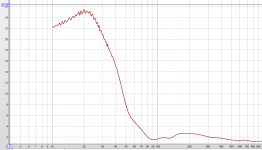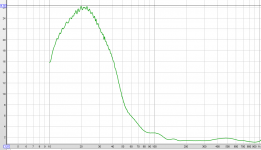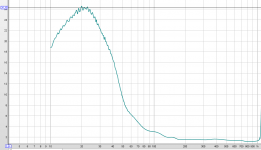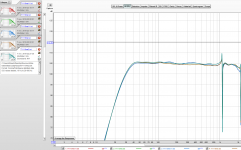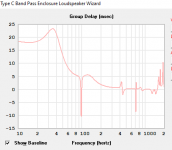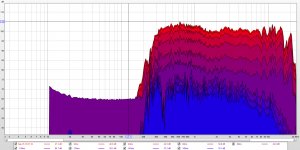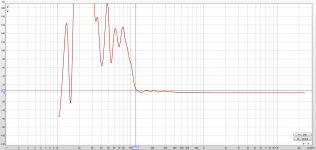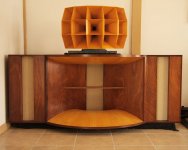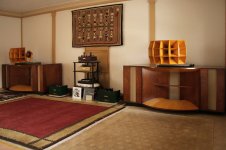The dark colored stuff in the middle and at the bottom?
Exatcly.
2x Pro Audio TL subs,
Wisdom Audio's Regenerative Transmission Line® :
AXIOM Manifolded Transmission Line:
Wisdom Audio's Regenerative Transmission Line® :
An externally hosted image should be here but it was not working when we last tested it.
AXIOM Manifolded Transmission Line:
An externally hosted image should be here but it was not working when we last tested it.
I was just going to comment on that when I saw your post. Only a little bit surprisingly, the tapped horn subwoofer community doesn't seem to have hit upon partially stuffing the pipe to tame some of the resonances those horns so clearly suffer from. No doubt its because that might cost a db or two at the very low end.
Don't say this in subwoofer forumI was just going to comment on that when I saw your post. Only a little bit surprisingly, the tapped horn subwoofer community doesn't seem to have hit upon partially stuffing the pipe to tame some of the resonances those horns so clearly suffer from. No doubt its because that might cost a db or two at the very low end.
Bjorno is the master of stuffing
Play with S1 area, L12 lengh, and stuffing only at the beginning of L23. And free to you to add low pass chamber (throat chamber) firing a S3/S4 depending if your in TH/TH1 mode... But it's totally off-topic; and i prefer weird dual reflex bandpass arrangements that now hornresp offers (BPB/PBC) ^^
Last edited:
Ignore this post if you already know this but maybe needs mentioning again.
I believe group delay is directly related to roll off so ported sealed or tl can have the same group delay if they all have the same roll off characteristics. Eq can change the group delay so depending on application it might not be an issue for you. Also the audibility of group delay in bass region is large before it becomes a problem. I don't have a source for this on hand right now.
Also just a quick note on my limited testing with linearization of phase in the bass region. I liked it better with no phase correction below 100hz but testing wasn't controlled well. I also couldnt tell zero phase VS slowly increasing phase wrap in a 2 way system. Used rephrase on the same system to test.
I believe group delay is directly related to roll off so ported sealed or tl can have the same group delay if they all have the same roll off characteristics. Eq can change the group delay so depending on application it might not be an issue for you. Also the audibility of group delay in bass region is large before it becomes a problem. I don't have a source for this on hand right now.
Also just a quick note on my limited testing with linearization of phase in the bass region. I liked it better with no phase correction below 100hz but testing wasn't controlled well. I also couldnt tell zero phase VS slowly increasing phase wrap in a 2 way system. Used rephrase on the same system to test.
I like to play with hornresp multiple entry horn and output frequency/phase to see group delay in REW. I'm not yet enough confortable with real crossover sofware, something that my brain don't want to work with whereas i love playing with hornresp. So, i play with ME1, the driver between the two others, to delay it more or less, filter more or less, to get with the same response curve, different group delay. Counter-intuitive, but with some destructive partially out of phase nulling, it works, and i start understanding how to move sliders to get what i want. But for that, i need a 3 ways driver at least for this "filler driver".Ignore this post if you already know this but maybe needs mentioning again.
I believe group delay is directly related to roll off so ported sealed or tl can have the same group delay if they all have the same roll off characteristics. Eq can change the group delay so depending on application it might not be an issue for you. Also the audibility of group delay in bass region is large before it becomes a problem. I don't have a source for this on hand right now.
Also just a quick note on my limited testing with linearization of phase in the bass region. I liked it better with no phase correction below 100hz but testing wasn't controlled well. I also couldnt tell zero phase VS slowly increasing phase wrap in a 2 way system. Used rephrase on the same system to test.
Here a example while i was trying to figure out how to remove the bumps in GD curve around 200-500hz. The only differences between all the curve are Eq/filters, and input power of the woofer filler driver working between 150-350 hz. The third picture shows promising effects.
And higher order sub (here a kind of 6th order bandpass 40-150hz set in hornresp as a 4th order bandpass + a lot of EQ to get same resultant FR/phase), needs + 5ms delay alignement of others ways as show when it group delay is showed separatly in last picture (don't look too much to artefacts).
Again...it's off-topic, sorry. Just to say, eq don't do all on phase. And FIR isn't anymore the futur ^^
Attachments
Last edited:
#Random
This is the Axi2050 group delay on a 250hz jmlc
Interesting. I would have thought a jmlc would have had significant group delay in the 250hz range with the posted frequency response.
Considering it’s group delay is tight down to almost 100 hertz, I personally think it’s more credit due to the driver than the horn.
Yes, it looks like Mark Dodd and Jack Oclee-Brown have succeeded in creating (by far) the best Titanium diaphragm ever, including the driver around it, of course.
Respectfully. Your group delay magnitude scale is misleading. The extreme issue below 100Hz is irrelevant to the lower passband. Jean-Michel had a preference to cross by 300uS in the varying region, I'm sorry I cannot find a post that says this. This becomes less critical below 250Hz.#Random
This is the Axi2050 group delay on a 250hz jmlc
Jean Michel on LeCleac'h hornsjmmlc said:The main problem I see when using a driver in a frequency interval very near of the acoustical cut-off frequency of the horn is the voice seeming to come from very far inside the horn. This can be explained by the group delay that rises very fast when the frequency decreases under 2.Fc
While we are about group delay, i've got some question i've never seen a definitive answer about ( and i don't expect it to be but...): in the 3 lower octave range ( 20/160hz) what value of gd are considered to be below audibility threshold?
Iirc below 40hz 24/25ms being considered acceptable and something like 8ms for 80hz.
What is your take on it?
Crossing at point where gd is equal ( wrt 2 adjacent way on a design) occured to me some days ago. I never really thought about it before. Is it a design target for some of you?
Camplo Axi2050 is impressive. Do you already have one?
Iirc below 40hz 24/25ms being considered acceptable and something like 8ms for 80hz.
What is your take on it?
Crossing at point where gd is equal ( wrt 2 adjacent way on a design) occured to me some days ago. I never really thought about it before. Is it a design target for some of you?
Camplo Axi2050 is impressive. Do you already have one?
Last edited:
Yes either that, or building up to that in a crossover can allow smooth blending over a wide range free from variations. I wouldn't necessarily say the same about time of flight delay.Crossing at point where gd is equal ( wrt 2 adjacent way on a design) occured to me some days ago. I never really thought about it before. Is it a design target for some of you?
I think this phenomenon about group delay and the lower spectrum is akin to the argument that sound below 200hz or is it 80hz, or what ever number you choose, isn’t locatable...to where this may be true for the general audience but some of us are more sensitive than others, yet more importantly, it’s just not detrimental to the experience. What happens is that even though it’s not taking away from the pleasure of audition it is changing the actual waveform and if you had a system who’s group delay within the bass was high but acceptable and direct comparison to a system with outstanding group delay performance, you will hear a difference and the system with the better group delay is more honest, so as a sound engineer you should desire the best group delay possible. I have found that with headphones I can be very meticulous with the crafting of bass compression because the group delay is so tight that I can hear the changes...amongst no room as well I guess. Group delay is to bass or signal in general as is the attack setting of the envelope. The woofer group delay at 50hz may be 25ms BUT the driver has the signal already at reference 0ms....so from 0 to 25ms it gradually reaches full amplitude, a crescendo, if you will. No different than the attack setting of the envelope. So from a purely spectators perspective maybe that’s fine, a minuet spin on the artist (engineers) original vision/intentions but, for the truest sense of critical listening, no. Am I worried about it? Not really because group delay among a lot of other things make super accurate bass production a huge (expensive) challenge, so....I have headphones for the intricate details and I use the loud speakers for level assessment. Transient response , is a somewhat controversial topic is it not, especially when talking about bass? Well group delay literally changes the transients shape from sharp to soft, the more extreme it gets.
Last edited:
- Home
- Loudspeakers
- Multi-Way
- Is it possible to cover the whole spectrum, high SPL, low distortion with a 2-way?
